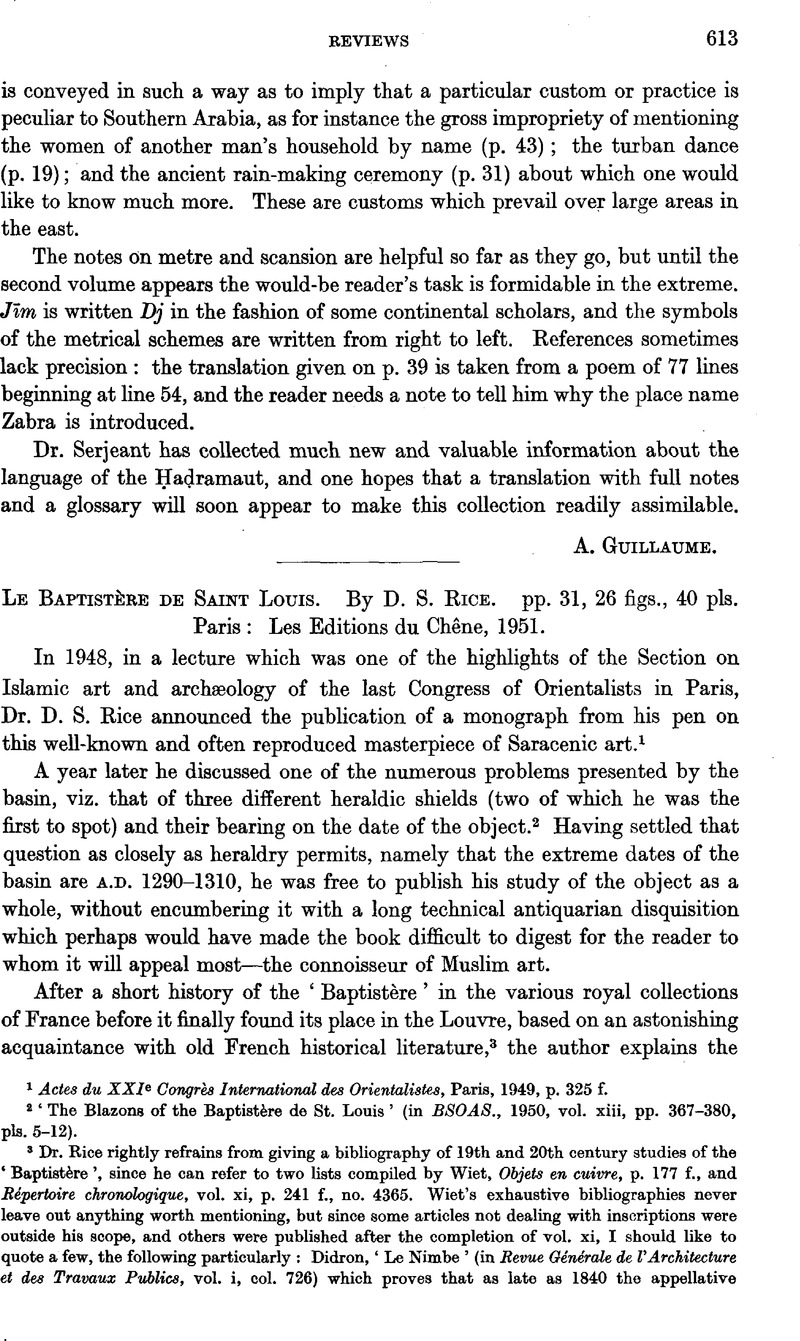No CrossRef data available.
Article contents
Le Baptistère de Saint Louis. By D. S. Rice. pp. 31, 26 figs., 40 pis. Paris: Les Editions du Chêne, 1951.
Published online by Cambridge University Press: 24 December 2009
Abstract

- Type
- Reviews
- Information
- Bulletin of the School of Oriental and African Studies , Volume 15 , Issue 3 , October 1953 , pp. 613 - 616
- Copyright
- Copyright © School of Oriental and African Studies 1953
References
page 613 note 1 Actes du XXIeCongrès International des Orientalistes, Paris, 1949, p. 325 f.Google Scholar
page 613 note 2 ‘The Blazons of the Baptistère de St. Louis’ (in BSOAS., 1950, vol. xiii, pp. 367–380, pls. 5–12).Google Scholar
page 613 note 3 Dr. Rice rightly refrains from giving a bibliography of 19th and 20th century studies of the ‘Baptistère’, since he can refer to two lists compiled by Wiet, , Objets en cuivre, p. 177 f.Google Scholar, and Répertoire chronologique, vol. xi, p. 241 f.Google Scholar, no. 4365. Wiet's exhaustive bibliographies never leave out anything worth mentioning, but since some articles not dealing with inscriptions were outside his scope, and others were published after the completion of vol. xi, I should like to quote a few, the following particularly: Didron, ‘Le Nimbe’ (in Revue Générale de l'Architecture et des Travaux Publics, vol. i, col. 726Google Scholar) which proves that as late as 1840 the appellative ‘Baptistère de St. Louis’ was not accepted yet, although (as Dr. Rice shows on p. 9) it was used already in 1791, Edouard Lièvre, Les Collections célèbres d'oeuvres d'art, t. i, pls. 47, 48, until Dr. Rice's book by far the best reproduction of the ‘Baptistère’; E. Kühnel, ‘Ibn ez-Zeîn’ (in Thieme-Becker, 's Allgem. Lexikon d. bild. Künstler, s.v., vol. 18, p. 454Google Scholar) the only article devoted to the maker of the ‘Baptistère’; and two paragraphs noteworthy because of the belief of their authors that the ‘Baptistère’ is of Syrian origin, viz. Dimand, ‘Metalwork’ (in Ars Islamica, 1941, vol. viii, p. 210Google Scholar); Aga-Oglu, , ‘About a type of Islamic incense burner’ (in Art Bulletin, 1945, vol. xxvii, p. 36, n. 68).Google Scholar
page 614 note 1 Lane-Poole, , Catalogue of Oriental coins in the British Museum, vol. iii, pl. viii, no. 398, pl. x, no. 53bGoogle Scholar; Lavoix, , Catalogue des monnaies musulmanes de la Bibliothèque Nationale, t. iii, pl. vi, nos. 621, 678Google Scholar; Edhem, I. Ghalib, Catalogne des monnaies turcomanas, pl. viii, nos. 191, 192, 194.Google Scholar
page 615 note 1 Of course there may be a different reason for it. Among what some Arabic epigraphists call inscriptions banales there is a class which begins with the word anâ, thus introducing the object itself as speaking to its owner or viewer. Although this type of inscription abounds mainly in North Africa and Spain—one thinks first of the famous verses in the Alhambra—many examples from the Near and Middle East are known as well. It is quite possible that Muḥammad b. az-Zain had a platter in mind which was decorated with such an inscription.
page 615 note 2 Qalqashandî, , Ṣubḥ, iii, pp. 472, 11. 16–19.Google Scholar




